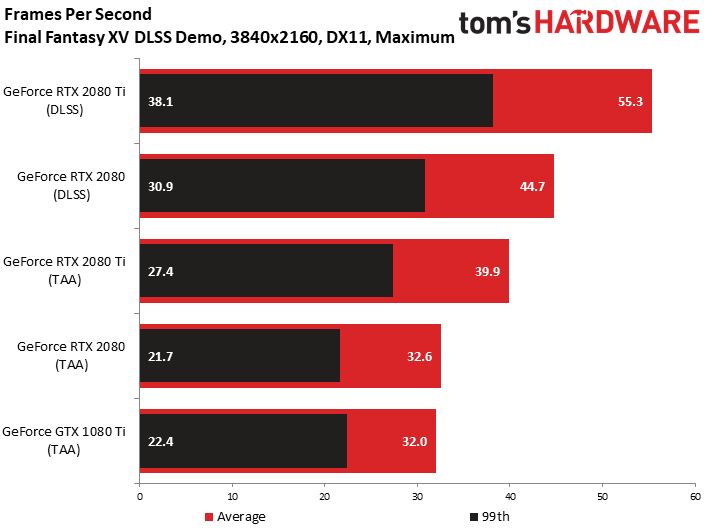Nvidia GeForce RTX 2080 Ti Founders Edition Review: A Titan V Killer
Why you can trust Tom's Hardware
Deep Learning Super-Sampling: Our First Taste of Quality and Performance
Before we get into the performance of GeForce RTX 2080 Ti across our benchmark suite, let’s acknowledge the elephant in the room: there are no games with real-time ray tracing to test. In fact, Windows 10 doesn’t even support this functionality yet unless you're in developer mode. Per Nvidia, “DirectX Ray Tracing and Windows ML will be made available to customers as part of the upcoming Windows 10 October 2018 Update.”
We do, however, have access to a demo of Final Fantasy XV Windows Edition with DLSS support. Details of the implementation are somewhat light, aside from a note that DLSS allows Turing-based GPUs to use half the number of input samples for rendering. The architecture’s Tensor cores fill in the rest to create a final image.



Nvidia says the demo runs at 4K and maximum graphics fidelity no matter what but doesn’t provide any way to see what the quality settings include. The HUD simply shows Resolution: 3840x2160, Graphics: Custom, and a score that increases as the demo runs.
Performance through the demo is most definitely improved by DLSS. The GeForce RTX 2080 Ti picks up a 39% speed-up with DLSS active compared to applying TAA at 4K. GeForce RTX 2080 is 37% faster with DLSS enabled. Otherwise, it’d be roughly as fast as a GeForce GTX 1080 Ti if both cards relied on TAA to combat aliasing artifacts.


Until DLSS really proves itself, we anticipate gamers distrusting the idea that input samples can be removed to save on rendering budget and then filled in using AI. We pored over the demo, running both versions over and over to identify any differences that stood out.
In the clip below, we make two observations. First, Noct’s textured shirt is affected by banding/shimmering due to DLSS. In the TAA version, his chest does not exhibit the same effect. Second, as Noct casts his fishing rod, there’s a pronounced ghosting artifact that remains on-screen with TAA active. DLSS does away with this entirely. Neither solution is perfect. Of course, we do like that DLSS adds hugely to the RTX cards’ performance results (a GeForce RTX 2080 Ti with DLSS is no less than 73% faster than a GeForce GTX 1080 Ti using TAA).
Might the Final Fantasy’s DLSS implementation improve over time? According to Nvidia, the model for DLSS is trained on a set of data that eventually reaches a point where the quality of its inferred results flattens out. So, in a sense, the DLSS model does mature. But the company’s supercomputing cluster is constantly training with new data on new games, so improvements may roll out as time goes on. If there are areas that demonstrate an issue of some sort, the DLSS model can be reviewed and tweaked. This may involve providing additional “correct” data to train with.
Get Tom's Hardware's best news and in-depth reviews, straight to your inbox.
More than anything, it’s good to get our hands on a DLSS-enabled demo we can scrutinize. As more DLSS-enabled titles become available, you can be sure we’ll spend time adjusting their anti-aliasing settings to compare performance and quality.
MORE: Best Graphics Cards
MORE: Desktop GPU Performance Hierarchy Table
MORE: All Graphics Content
Current page: Deep Learning Super-Sampling: Our First Taste of Quality and Performance
Prev Page GeForce RTX 2080 Ti Founders Edition Next Page High Dynamic Range: Improving Performance and Input Latency-
A Stoner Conclusion, let them hold onto these card until they can lower the price to about $700Reply -
pontiac1979 "Waste of time to write a review. "Just buy it"."Reply
Oh yeah, god forbid Tom's does an in-depth review of the latest and greatest. Keyword greatest. If you desire 4K gaming and have the funds available, why wouldn't you? -
ubercake I'm probably going to buy one... Though it's not my fault... I feel like the Russians are compelling me to do this by way of Facebook. I'm a victim in this whole Nvidia marketing scam. Don't judge.Reply
That being said, I like high-quality, high-speed graphics performance. This may also be influencing my decision.
Great review! -
AnimeMania How much of the performance increase is due to using GDDR6 memory? I know this makes the cards perform better the higher the resolution is, how does it effect other aspects of the video cards.Reply -
teknobug "Just buy it" they said...Reply
If you're in Canada, you might not want to pay the price of these. -
chaosmassive While I appreciate this very detailed and nicely written review, its kinda redundantReply
because I think Avram has already reviewed this card with his opinion on late august
with the conclusion was "just buy it" -
wiyosaya SMH I don't understand the reasoning for comparing a $3k known non-gaming card with a $1.2k gaming card. Are there really gamers our there ignorant enough, other than those with deep pockets who want bragging rights, to purchase the $3K card for gaming when they know it is not meant for gaming? Or is this to differentiate Tom's from the other tech sites in order to inspire confidence in Tom's readers?Reply
Personally, I would have rather seen the 2080 Ti compared against 1080 Ti even if it Tom's comes to the same conclusions as the other tech web sites.
The comparison in this article does not make me want to rush out and buy it because it is $1.8k cheaper than a non-gaming card. I really hate to say it, but with the premise of this review being somewhat along the lines of "lookie hereee kiddies. Heree's a gaming card for $1.2k that beets a $3k non-gaming card" turned this review into a TL;DR review for me.




